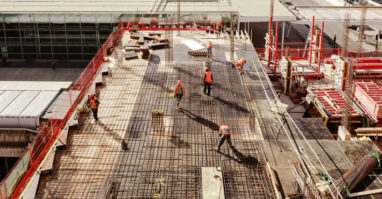As a contractor, your work requires logical forethought and mathematical precision. After all, you measure twice, cut once, right? In this industry, “re” terms generally have negative connotations. Words like “recut,” “reinstall,” and “rework” are generally synonymous with “lost revenue.” So it’s easy to understand why contractors may find it challenging to reframe (no pun intended) their mindsets when developing a post-pandemic business model that includes the necessary rework to accommodate the continued and evolving effects of the pandemic.
Construction companies of every size, shape, and makeup have been affected in one way or another. But, with readjustments occurring across the board, how is it that some companies, even those with similar size and makeup, are faring better than others in developing successful strategies? For many contractors, their success depends on relearning to do more with less and – you guessed it – their ability to recognize the place for a handful of other “re” terms in developing and maintaining their post-pandemic business model.
Refocus on softer skills.
As you restore operations, it’s essential to remember it’s not all about the numbers. Refocusing on soft skills can help you stay true to your company’s mission, values, and culture. Here are a few things to focus on and some questions to ask as you refocus your efforts.
Leadership – Are you setting a positive tone and leading by example from the top? Are you a unified front when presenting new policies and procedures to your employees? Is everyone on your management team encouraging employee accountability, production, collaboration and morale?
Communication – Are you openly communicating your company’s strategy, continuity plans, and recovery efforts with employees and customers? Have you been leveraging existing and new networking opportunities?
Empowerment & Self-Motivation – Are you recognizing employee accomplishments? Could you invest more in employee training to reduce on-the-job injuries, lower legal liabilities and risk, and increase job productivity? Are you providing employees with everything they need to be self-sufficient?
Reassess operations and procedures.
Review your operations and procedures for missed opportunities that increase efficiency and productivity and reduce costs. Here are some considerations and questions to ask as you make your assessment.
Job Costing -Does your job costing system help you generate enough revenue to exceed your costs and remain in line with competitor pricing? Are you able to capture scheduling and delay costs promptly to prepare for possible future claims? Does your system help you account for things like increases in suppliers’ pricing, COVID-19 related costs, and additional labor and equipment costs?
Project Management – Are project managers setting realistic, achievable goals and setting reasonable timelines? Are they able to manage customer expectations appropriately? Could they improve their time management?
Risk Management – Are you staying on top of contracts receivable, accounts payable, billing, changes in your bank line of credit, and loan balances? What methods are you using to evaluate risks involved with current projects? Are you prioritizing new business by type of work, the time frame, and bonding requirements? Are you taking the appropriate precautions when subcontracting work?
Reappraise technology and data analytics.
Technology and Big Data are critical factors in your ability to evolve with the changing needs of the industry and market. Here are some considerations and questions as you reappraise the value and potential ROI of these solutions.
Automated Solutions – Could your request for information (RFI) process, job costing, risk assessments, asset management, project management, or customer relationship management be streamlined with automation? Have you considered automated reality (AR) to detect errors before breaking ground or for training purposes?
Data Analytics – Do you use job costing software that allows you to report on valuable information, such as cost-to-complete, budget to actual, and labor productivity? Do you employ the Internet of Things (IoT), using devices and sensor data on your equipment to assess performance and help you with predictive maintenance?
Reach out to a professional advisor.
ARB’s Construction & Real Estate Services Group provides industry-specialized accounting, tax, and advisory services for construction start-ups, established firms, and the contractors that own them.
I help contractors with job costing, overhead cost calculations, profitability analyses, forecasts, projections, and more to develop and maintain a post-pandemic business model that best suits their needs. If you’re ready to reshape your business model, contact me today to get started.
by David Jean, CPA, CCIFP, CExP
David Jean is a principal at ARB and the Practice Leader for the firm’s Construction & Real Estate, Succession Planning, Professional Services Firms, and Business Advisory Services Teams. David provides specialized tax, financial accounting, and business advisory services primarily to construction, real estate, and manufacturing companies. He is a member of the NASBP’s Certified Public Accountant Advisory Council. As a Certified Exit Planner and the Director of Altus Exit Strategies, a wholly-owned subsidiary of ARB, David uses The Seven Step Exit Planning Process™ to help business owners and their exit teams create, customize, implement, and successfully execute comprehensive succession and exit plans.






